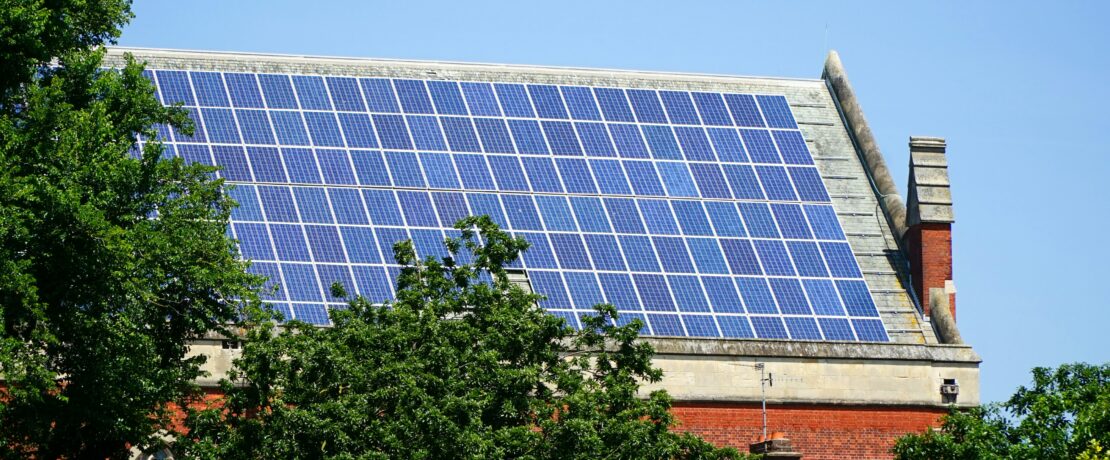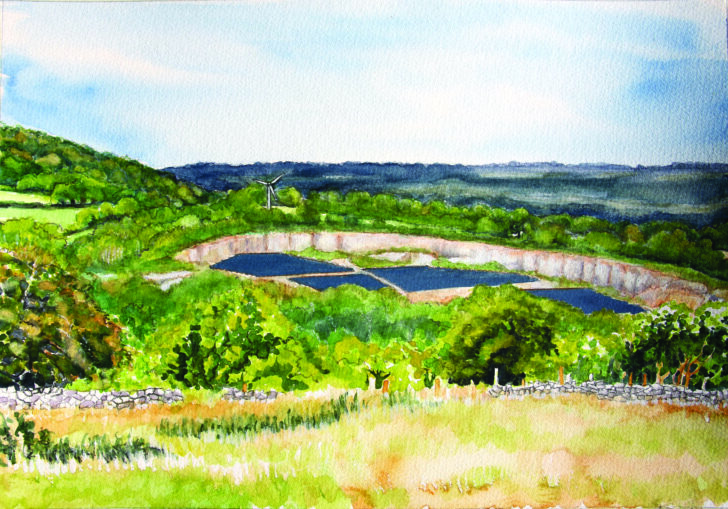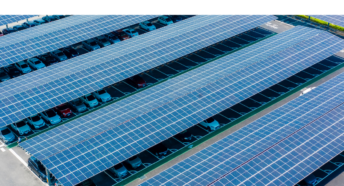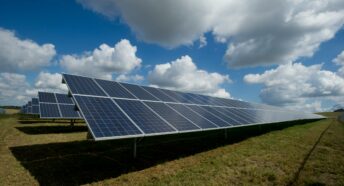Community energy climate champions

CPRE’s networks of groups have been pioneering new approaches to bottom-up planning for renewables.
Community champions
While investment in mega-projects such as offshore wind is essential, there is a role for communities and councils in helping the local roll-out of renewable energy – and CPRE can play a part.
Andy Tickle reports CPRE has long championed the need for local, proactive approaches to address big planning and environmental challenges. Given that climate breakdown is the biggest threat to the countryside, the looming challenge to decarbonise the energy system is ever more urgent. Now the Labour government has thrown down the gauntlet with a new 2030 clean power target, so it is clearly time to grasp the nettle.
CPRE strongly supports renewables done well – made clear in its groundbreaking 2020 ‘Greener, better, faster’ vision of a decentralised, zero-carbon energy system that empowers and benefits local communities, and is delivered in harmony with our natural environment and landscapes. In that vision, CPRE saw the need to empower local authorities, local people and more democratically engaged bodies to positively shape their energy futures. What’s been happening across the country since, and what can other areas learn?
Councils with attitude
Back in 2020, a housing design audit co-led by CPRE and UCL found that the loss of the Code for Sustainable Homes in 2015 had led to a substantial backward step in the energy efficiency performance of new housing developments. This showed a clear need for CPRE locally to take the lead in supporting local authorities who want to set the climate performance standards we need. Now many local councils are responding brilliantly to community initiatives and local CPRE action, frequently focusing on rooftop solar, which is seen as a quick win.
In a new research report from CPRE’s North West regional group, the role of Cumbria Action for Sustainability’s (CAfS) solar-focused work is highlighted. After Kendal held the first-ever town-level citizens’ jury on climate change, the town council commissioned a solar rooftop audit. In 2022 – with CAfS – it then launched its ‘Solar Made Easy’ project, combining the audit with grants and installers to speed up roof solar uptake. Friends of the Lake District, the group that represents CPRE in Cumbria, has strongly supported the work.
Not far away, South Ribble Borough Council published a Climate Emergency Action Plan in 2021, pledging to be net zero by 2030. Over the past five years, driven by a councillor-led Climate Emergency Task Group, the council has made major steps to reduce carbon usage. Funded in part by government grants and enabled by innovative procurement models, many public buildings and facilities have had significant makeovers, all contributing to the council’s net zero goal. Rooftop solar has played a big role in this carbon reduction work, with energy upgrades to major council buildings, including EV chargers, air source heat pumps, batteries, solar roofs on four leisure centres, several refurbished offices and new social housing.
One scheme involved transforming a vacant patch of land in Bamber Bridge in 2023 into 15 affordable and energy efficient homes with solar panels and comprehensive energy efficiency measures. ‘The McKenzie Arms development was a flagship development for us where we proved that good-quality homes can still be affordable and energy efficient,’ says Councillor Jacky Alty, Leader of South Ribble Borough Council. ‘Elsewhere we are delivering a full decarbonisation programme across our four leisure centres, making them fit for the future, and we are currently in development of a new energy efficient extra care facility for the over-55s that will allow people to live more affordably and longer in their own homes. We are dedicated to meeting our net zero aims, and while we are making positive changes, we are actively working across our communities to support others to do the same.’

Enabling visions and audits
Enabling widespread local action on net zero and renewables doesn’t happen in a vacuum. Since 2020, CPRE’s networks of groups have been pioneering new approaches to bottom-up planning for renewables through the award-winning Community Energy Vision project. Initially piloted in three communities in North Yorkshire in 2020-21 and
then rolled out across the country, a series of weekly workshops allows communities to guide appropriately scaled renewables to the best locations in their parish or area, and plan heat and energy efficiency upgrades. In Bonsall in Derbyshire, with the process being led by CPRE Derbyshire and CPRE Peak District and South Yorkshire, this led to the rebirth of the Bonsall Energy Group, which has since secured Community Energy Fund support for feasibility studies of potential wind and solar schemes at three sites across the parish (one in the former quarry, illustrated). A crucial element of the vision document is the commissioning of an artist’s impressions of the chosen technology, allowing the community to understand and accept the capacity of their local landscape to change.
CPRE in Hampshire and Sussex have also kickstarted a rooftop revolution across their counties. Funded by the Centre for the South’s New Things Fund, University of Southampton researchers developed a new solar mapping tool that has analysed every roof across East Sussex, West Sussex, Brighton and Hove, and Hampshire. The results have been galvanising. ‘The research has generated significant interest with Sussex councils and community energy groups. Many are hoping to use the work to identify priority sites and neighbourhoods, to engage communities in getting more solar on roofs and to feed into local energy planning,’ says Paul Steedman, director at CPRE Sussex.
Paul clearly acknowledges, however, that we can’t meet all our solar energy (and hence essential climate) goals on the timescales that we need, via rooftops and car park canopies alone. ‘So it’s critical that, while we need to max out the rooftop potential, we also acknowledge the need for ground-mounted solar “done well” – with limited landscape impacts, high biodiversity and/or agrivoltaics, at a scale that doesn’t swamp neighbouring communities, and ideally owned by the community.’ With poorly sited mega solar parks causing consternation in some parts of the country, this is a big ask.
The planning challenge
As well as ensuring their own operations and building stock are maxed out for net zero, local councils have a big role to play in using their local plans to bring about vital changes. Recent volunteer-led research by CPRE North and East Yorkshire, doing detailed audits of eight local authority plans, suggests shortfalls. ‘Councils’ performance on CO2 emissions reduction in new construction, both against the commitments stated in their current local plans, and against what’s actually needed in policy terms to properly address the climate crisis, has a long way to go,’ reports CPRE North and East Yorkshire’s project lead, Sally Learoyd. ‘As a result, we are lobbying for local authorities to urgently introduce local plan policy that mandates all new housing, and non-residential development, be built to net zero standard.’
The group’s vice chair, Katie Atkinson, adds, ‘You only have to look at Cornwall Council for a real leadership example of what’s possible. Cornwall’s Climate Emergency Development Plan Document, adopted in 2023, addresses the full gamut of climate-related planning policies, including a net zero construction standard. The council
went on to win the 2024 RTPI national award for planning excellence!’
With a new government wanting to double down on renewables delivery, including trebling solar uptake, secretary of state Ed Miliband quickly endorsed CPRE’s call for a ‘rooftop revolution’. The government has also been quick out of the blocks on planning reforms needed for net zero – also the subject of CPRE, Aldersgate Group and RenewableUK’s Electric Dreams report (see page 4).
Looking to the future, the government’s new Clean Power 2030 Action Plan also gives a further, strong impetus to local and community energy, which it identifies as ‘playing a vital role… delivering significant local benefits and reducing network losses by bringing generation closer to electricity demand’. Great British Energy is also tasked with delivering a new Local Power Plan, providing funding and support to local authorities, mayoral combined authorities and community energy groups to reach a target of 8GW (gigawatts; current community energy schemes, existing and projected, total about 0.8GW). With new big targets for rooftop solar on warehousing and car parks, it seems that CPRE’s solar campaign is really gaining traction!
Five ways to help your area decarbonise
- Map suitable roofs in your area for solar panels.
- Challenge your council to create a net zero development plan.
- Find out what your council is doing in its own buildings to reduce carbon emissions.
- Make sure that when your council is commissioning new social housing it includes zero-carbon measures.
- Create a local community energy group to explore options for your area.
About the author
Andy Tickle is a freelance planning and campaign consultant, specialising in energy and minerals. He worked for CPRE Peak District and South Yorkshire from 2002-22, including six years as director.









